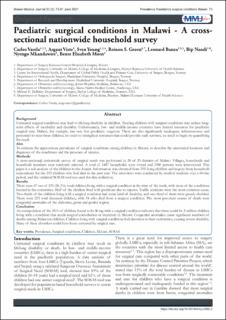| dc.description.abstract | Background
Untreated surgical conditions may lead to lifelong disability in children. Treating children with surgical conditions may reduce long-term effects of morbidity and disability. Unfortunately, low- and middle-income countries have limited resources for paediatric surgical care. Malawi, for example, has very few paediatric surgeons. There are also significantly inadequate infrastructures and personnel to treat these children. In order to strengthen resources that could provide such services, we need to begin by quantifying the need.
Aim
To estimate the approximate prevalence of surgical conditions among children in Malawi, to describe the anatomical locations and diagnoses of the conditions and the presence of injuries.
Methods
A cross-sectional, nationwide survey of surgical needs was performed in 28 of 29 districts of Malawi. Villages, households and household members were randomly selected. A total of 1487 households were visited and 2960 persons were interviewed. This paper is a sub analysis of the children in the dataset. Information was obtained from 255 living children and inquiry from household respondents for the 255 children who had died in the past year. The interviews were conducted by medical students over a 60-day period, and the validated SOSAS tool was used for data collection.
Results
There were 67 out of 255 (26.3%) total children living with a surgical condition at the time of the study, with most of the conditions located in the extremities. Half of the children lived with problems due to injuries. Traffic accidents were the most common cause. Two-thirds of the children living with a surgical condition had some kind of disability, and one-third of them were grossly disabled. There were 255 total deceased children, with 34 who died from a surgical condition. The most prevalent causes of death were congenital anomalies of the abdomen, groin and genital region.
Conclusion
An extrapolation of the 26% of children found to be living with a surgical condition indicates that there could be 2 million children living with a condition that needs surgical consultation or treatment in Malawi. Congenital anomalies cause significant numbers of deaths among Malawian children. Children living with surgical conditions had disorders in their extremities, causing severe disability. Many of these disorders could have been corrected by surgical care. | en_US |

